Long-Range Static and Dynamic Previtreous Effects in Supercooled Squalene—Impact of Strong Electric Field
Abstract
:1. Introduction
2. Results and Discussion
3. Experimental
4. Conclusions
Author Contributions
Funding
Institutional Review Board Statement
Informed Consent Statement
Data Availability Statement
Conflicts of Interest
Sample Availability
References
- Kim, S.K.; Karadeniz, F. Biological importance and applications of squalene and squalane. Adv. Food Nutr. Res. 2012, 65, 223–233. [Google Scholar]
- Rao, C.V.; Newmark, H.L.; Reddy, B.S. Chemopreventive effect of squalene on colon cancer. Carcinogenesis 1998, 19, 287–290. [Google Scholar] [CrossRef] [Green Version]
- Passi, S.; De Pità, O.; Puddu, P.; Littarru, G.P. Lipophilic antioxidants in human sebum and aging. Free Radic. Res. 2002, 36, 471–477. [Google Scholar] [CrossRef]
- Huang, Z.R.; Lin, Y.K.; Fang, J.Y. Biological and pharmacological activities of squalene and related compounds: Potential uses in cosmetic dermatology. Molecules 2009, 14, 540–554. [Google Scholar] [CrossRef]
- Camera, E.; Ottaviani, M.; Picardo, M. Squalene chemistry and biology. In Lipids and Skin Health; Papas, A., Ed.; Springer: Berlin, Germany, 2014; pp. 185–198. [Google Scholar]
- Bhilwade, H.N.; Tatewaki, N.; Nishida, H.; Konishi, T. Squalene as Novel Food Factor. Curr. Pharm. Biotechnol. 2010, 11, 875–880. [Google Scholar] [CrossRef]
- Seçmeler, Ö.; Galanakis, C.M. (Eds.) Innovations in Traditional Foods; Woodhead Publishing—Elsevier: Amsterdam, The Netherlands, 2019. [Google Scholar]
- Kowert, B.A.; Watson, M.B. Diffusion of organic solutes in squalane. J. Phys. Chem. B 2011, 115, 9687–9694. [Google Scholar] [CrossRef] [PubMed]
- Ruiz-Mercado, G.; Cabezas, H. Sustainability in the Design, Synthesis and Analysis of Chemical Engineering Process; Butterworth-Heinemann: Amsterdam, The Netherlands, 2016. [Google Scholar]
- Gohil, N.; Bhattacharjee, G.; Khambhati, K.; Braddick, D.; Singh, V. Corrigendum: Engineering strategies in microorganisms for the enhanced production of squalene: Advances, challenges and opportunities. Front. Bioeng. Biotech. 2019, 7, 50. [Google Scholar] [CrossRef] [PubMed]
- Dean, J.A. Lange’s Handbook of Chemistry; McGraw-Hill: New York, NY, USA, 1999. [Google Scholar]
- Berthier, L.; Ediger, M. Facets of glass physics. Phy. Today 2016, 69, 40–44. [Google Scholar] [CrossRef] [Green Version]
- Lubchenko, V. Glass transition imminent, resistance is futile. Proc. Natl. Acad. Sci. USA 2017, 114, 3289–3291. [Google Scholar] [CrossRef] [PubMed] [Green Version]
- Ninarello, A.; Berthier, L.; Coslovich, D. Models and algorithms for the next generation of glass transition studies. Phys. Rev. X 2017, 7, 021039. [Google Scholar] [CrossRef] [Green Version]
- Kremer, F.; Loidl, A. Scaling of Relaxation Processes; Springer: Berlin, Germany, 2018. [Google Scholar]
- Angell, C.A. Strong and fragile liquids. Relaxations in Complex Systems; Ngai, K.L., Wright, G.B., Eds.; National Technical Information Service, U.S. Dept. of Commerce: Springfield, MA, USA, 1985; pp. 3–11.
- Böhmer, R.; Ngai, K.L.; Angell, C.A.; Plazek, D.J. Nonexponential relaxations in strong and fragile glass formers. J. Chem. Phys. 1993, 99, 4201–4209. [Google Scholar] [CrossRef]
- Vogel, H. Das temperature-abhängigketsgesetz der viskosität von flüssigkeiten. Phys. Zeit. 1921, 22, 645–646. [Google Scholar]
- Fulcher, G.S. Analysis of recent measurements of the viscosity of glasses. J. Am. Cerami. Soc. 1925, 8, 339–355. [Google Scholar] [CrossRef]
- Tammann, G. Glasses as supercooled liquids. J. Soc. Glass Technol. 1925, 9, 166–185. [Google Scholar]
- Mauro, J.C.; Yue, Y.; Ellison, A.J.; Gupta, P.K.; Allan, D.C. Viscosity of glass-forming liquids. Proc. Natl. Acad. Sci. USA 2009, 106, 19780–19784. [Google Scholar] [CrossRef] [Green Version]
- Romanini, M.; Garcia, J.C.M.; Tamarit, J.L.; Rzoska, S.; Barrio, M.; Pardo, L.C.; Drozd-Rzoska, A. Scaling the dynamics of orientationally disordered mixed crystals. J. Chem. Phys. 2009, 131, 184504. [Google Scholar] [CrossRef]
- Drozd-Rzoska, A.; Rzoska, S.J.; Pawlus, S.; Garcia, J.C.M.; Tamarit, J.-L. Evidence for critical-like behavior in ultraslowing glass-forming systems. Phys. Rev. E 2010, 82, 031501. [Google Scholar] [CrossRef] [PubMed]
- Drozd-Rzoska, A.; Rzoska, S.J.; Pawlus, S.; Tamarit, J.L. Dielectric relaxation in compressed glassy and orientationally disordered mixed crystals. Phys. Rev. B 2006, 74, 064201. [Google Scholar] [CrossRef]
- Drozd-Rzoska, A. Heterogeneity-related dynamics in isotropic n-pentylcyanobiphenyl. Phys. Rev. E 2006, 73, 022501. [Google Scholar] [CrossRef]
- Drozd-Rzoska, A. Glassy dynamics of liquid crystalline 4′-n-pentyl-4-cyanobiphenyl in the isotropic and supercooled nematic phases. J. Chem. Phys. 2009, 130, 234910. [Google Scholar] [CrossRef] [PubMed]
- Donth, E.J. The Glass Transition. Relaxation Dynamics in Liquids and Disordered Materials; Springer: Berlin, Germany, 2004. [Google Scholar]
- Rzoska, S.J.; Mazur, V.; Drozd-Rzoska, A. (Eds.) Metastable Systems under Pressure; Springer: Berlin, Germany, 2010. [Google Scholar]
- Drozd-Rzoska, A.; Rzoska, S.J.; Ziolo, J.; Czuprynski, K. Nonlinear dielectric studies in supercooling 4-(2-methylbutyl)-4′-cyanobiphenyl (5* CB). J. Physics Condens. Matter 1999, 11, L473–L476. [Google Scholar] [CrossRef]
- Young-Gonzales, A.R.; Adrjanowicz, K.; Paluch, M.; Richert, R. Nonlinear dielectric features of highly polar glass formers: Derivatives of propylene carbonate. J. Chem. Phys. 2017, 147, 224501. [Google Scholar] [CrossRef]
- Häberle, U.; Diezemann, G. Kerr effect as a tool for the investigation of dynamic heterogeneities. J. Chem. Phys. 2006, 124, 044501. [Google Scholar] [CrossRef] [PubMed] [Green Version]
- Rzoska, S.J.; Drozd-Rzoska, A. Dual field nonlinear dielectric spectroscopy in a glass forming EPON 828 epoxy resin. J. Phys. Condens. Matter 2011, 24, 035101. [Google Scholar] [CrossRef] [PubMed]
- Gadige, P.; Albert, S.; Michl, M.; Bauer, T.; Lunkenheimer, P.; Loidl, A.; Ladieu, F. Unifying different interpretations of the nonlinear response in glass-forming liquids. Phys. Rev. E 2017, 96, 032611. [Google Scholar] [CrossRef] [Green Version]
- Albert, S.; Bauer, T.; Michl, M.; Biroli, G.; Bouchaud, J.P.; Loidl, A.; Ladieu, F. Fifth-order susceptibility unveils growth of thermodynamic amorphous order in glass-formers. Science 2016, 352, 1308–1311. [Google Scholar] [CrossRef] [PubMed] [Green Version]
- Michl, M.; Bauer, T.; Lunkenheimer, P.; Loidl, A. Nonlinear dielectric spectroscopy in a fragile plastic crystal. J. Chem. Phys. 2016, 144, 114506. [Google Scholar] [CrossRef] [Green Version]
- Richert, R. Perspective: Nonlinear approaches to structure and dynamics of soft materials. J. Chem. Phys. 2018, 149, 240901. [Google Scholar] [CrossRef] [Green Version]
- Richert, R. (Ed.) Nonlinear Dielectric Spectroscopy; Springer: Berlin, Germany, 2018. [Google Scholar]
- Stanley, H.E. Introduction to Phase Transition and Critical Phenomena; Oxford University Press: Oxford, UK, 1971 and 1987.
- Anisimov, M.A. Critical Phenomena in Liquids and Liquid Crystals; Gordon and Breach: Reading, UK, 1994. [Google Scholar]
- Gitterman, M. Chemistry versus Physics. Chemical Reactions Near Critical Points; World Scientific Publishing: London, UK, 2010. [Google Scholar]
- Drozd-Rzoska, A.; Starzonek, S.; Rzoska, S.J.; Łoś, J.; Kutnjak, Z.; Kralj, S. Pretransitional Effects of the Isotropic Liquid–Plastic Crystal Transition. Molecules 2021, 26, 429. [Google Scholar] [CrossRef]
- Available online: https://www.novocontrol.de/php/a_harm.php (accessed on 24 September 2021).
- Chelkowski, A. Dielectric Physics; PWN-Elsevier: Warsaw, Poland, 1990. [Google Scholar]
- Sylwester, J.R.; Victor, A.M. (Eds.) Soft Matter under Exogenic Impacts; NATO Sci. Series II; MazurSpringer: Berlin, Germany, 2007; Volume 242. [Google Scholar]
- Rzoska, S.; Zioło, J.; Drozd-Rzoska, A.; Tamarit, J.L.; Veglio, N. New evidence for a liquid–liquid transition in a one-component liquid. J. Phys. Condens. Matter 2008, 20, 244124. [Google Scholar] [CrossRef]
- Stevenson, J.D.; Wolynes, P.G. Thermodynamic−Kinetic Correlations in Supercooled Liquids: A Critical Survey of Experimental Data and Predictions of the Random First-Order Transition Theory of Glasses. J. Phys. Chem. B 2005, 109, 15093–15097. [Google Scholar] [CrossRef] [PubMed] [Green Version]
- Stickel, F.; Fischer, E.W.; Richert, R. Dynamics of glass-forming liquids. II. Detailed comparison of dielectric relaxation, dc-conductivity, and viscosity data. J. Chem. Phys. 1996, 104, 2043–2055. [Google Scholar] [CrossRef]
- Drozd-Rzoska, A. Universal behavior of the apparent fragility in ultraslow glass forming systems. Sci. Rep. 2019, 9, 1–9. [Google Scholar]
- Drozd-Rzoska, A. Pressure-related universal previtreous behavior of the structural relaxation time and apparent fragility. Front. Mater. 2019, 6, 103. [Google Scholar] [CrossRef]
- Jonscher, A.K. The ‘universal’ dielectric response. Nature 1977, 267, 673–679. [Google Scholar] [CrossRef]
- Nielsen, A.I.; Christensen, T.; Jakobsen, B.; Niss, K.; Olsen, K.N.N.B.; Richert, R.; Dyre, J.C. Prevalence of approximate t relaxation for the dielectric α process in viscous organic liquids. J. Chem. Phys. 2009, 130, 154508. [Google Scholar] [CrossRef] [PubMed] [Green Version]
- Nielsen, A.I.; Pawlus, S.; Paluch, M.; Dyre, J.C. Pressure dependence of the dielectric loss minimum slope for ten molecular liquids. Philos. Mag. 2008, 88, 4101–4108. [Google Scholar] [CrossRef]
- Garcia, J.C.M.; Tamarit, J.L.; Rzoska, S.J. Prevalence for the universal distribution of relaxation times near the glass transitions in experimental model systems: Rodlike liquid crystals and orientationally disordered crystals. J. Chem. Phys. 2011, 134, 144505. [Google Scholar] [CrossRef]
- Dyre, J.C.; Olsen, N.B. Landscape equivalent of the shoving model. Phys. Rev. E 2004, 69, 042501. [Google Scholar] [CrossRef] [Green Version]
- Hecksher, T.; Nielsen, A.I.; Olsen, N.B.; Dyre, J.C. Little evidence for dynamic divergences in ultraviscous molecular liquids. Nat. Phys. 2008, 4, 737–741. [Google Scholar] [CrossRef]
- Garcia, J.C.M.; Rzoska, S.J.; Drozd-Rzoska, A.; Martinez-Garcia, J. A universal description of ultraslow glass dynamics. Nat. Commun. 2013, 4, 1–9. [Google Scholar]
- Garcia, J.C.M.; Rzoska, S.J.; Drzozd-Rzoska, A.; Martinez-Garcia, J.; Mauro, J. Divergent dynamics and the Kauzmann temperature in glass forming systems. Sci. Rep. 2014, 4, 5160. [Google Scholar] [CrossRef] [PubMed] [Green Version]
- Garcia, J.C.M.; Rzoska, S.J.; Drozd-Rzoska, A.; Starzonek, S.; Mauro, J. Fragility and basic process energies in vitrifying systems. Sci. Rep. 2015, 5, 8314. [Google Scholar] [CrossRef] [PubMed]
- Herweg, J. Die elektrischen Dipole in flüssigen Dielektricis. Z. Für Phys. 1920, 3, 36–47. [Google Scholar] [CrossRef] [Green Version]
- Debye, P. Die elektrischen Dipole in flüssigen Dielektricis. Phys. Z. 1935, 36, 193. [Google Scholar]
- Piekara, A.; Piekara, B. Saturation électrique dans les liquides purs et leurs mélanges. CR Acad. Sci. 1936, 203, 852. [Google Scholar]
- Piekara, A. Saturation electrique et point critique de dissolution (presente par Aime Cotton). CR Acad Sci. Paris 1936, 203, 1058–1059. [Google Scholar]
- Rzoska, S.J. Kerr effect and the nonlinear dielectric effect on approaching the critical consolute point. Phys. Rev. E 1993, 48, 1136–1141. [Google Scholar] [CrossRef]
- Drozd-Rzoska, A.; Rzoska, S.J.; Martinez-Garcia, J.C. Nonlinear dielectric effect in supercritical diethyl ether. J. Chem. Phys. 2014, 141, 094907. [Google Scholar] [CrossRef]
- Drozd-Rzoska, A.; Rzoska, S.J.; Zioło, J. Mean-field behaviour of the low frequency non-linear dielectric effect in the isotropic phase of nematic and smectic n-alkylcyanobiphenyls. Liq. Cryst. 1996, 21, 273–277. [Google Scholar] [CrossRef]
- Drozd-Rzoska, A.; Rzoska, S.J.; Zioło, J. High-pressure studies of the low-frequency nonlinear dielectric effect in the isotropic phaseof octyl- and dodecylcyanobiphenyls. Phys. Rev. E 1997, 55, 2888–2891. [Google Scholar] [CrossRef]
- Drozd-Rzoska, A.; Rzoska, S.J.; Czupryński, K. Phase transitions from THE isotropic liquid to liquid crystalline mesophases studied by linear and nonlinear static dielectric permittivity. Phys. Rev. E 2000, 61, 5355–5360. [Google Scholar] [CrossRef] [PubMed]


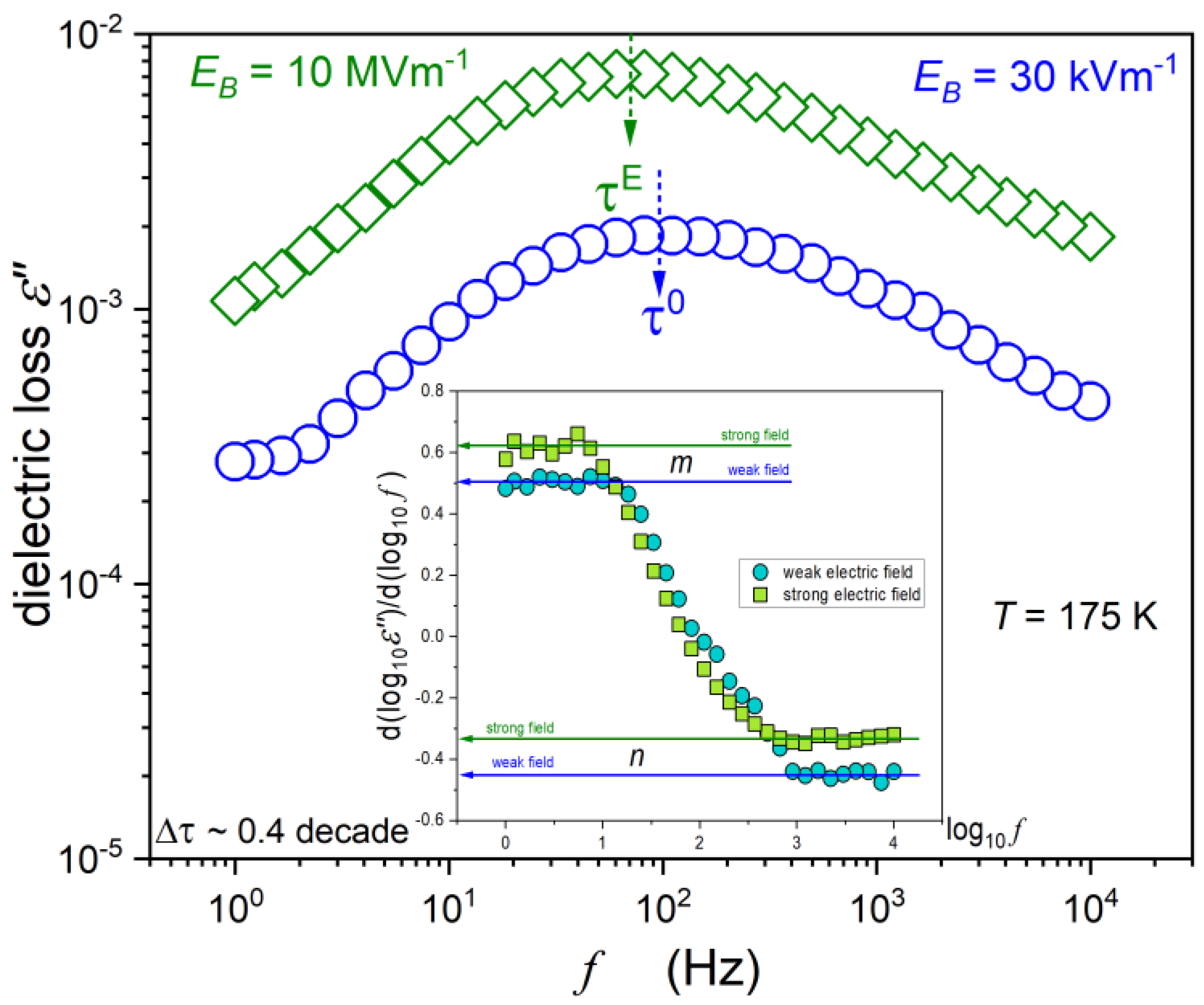
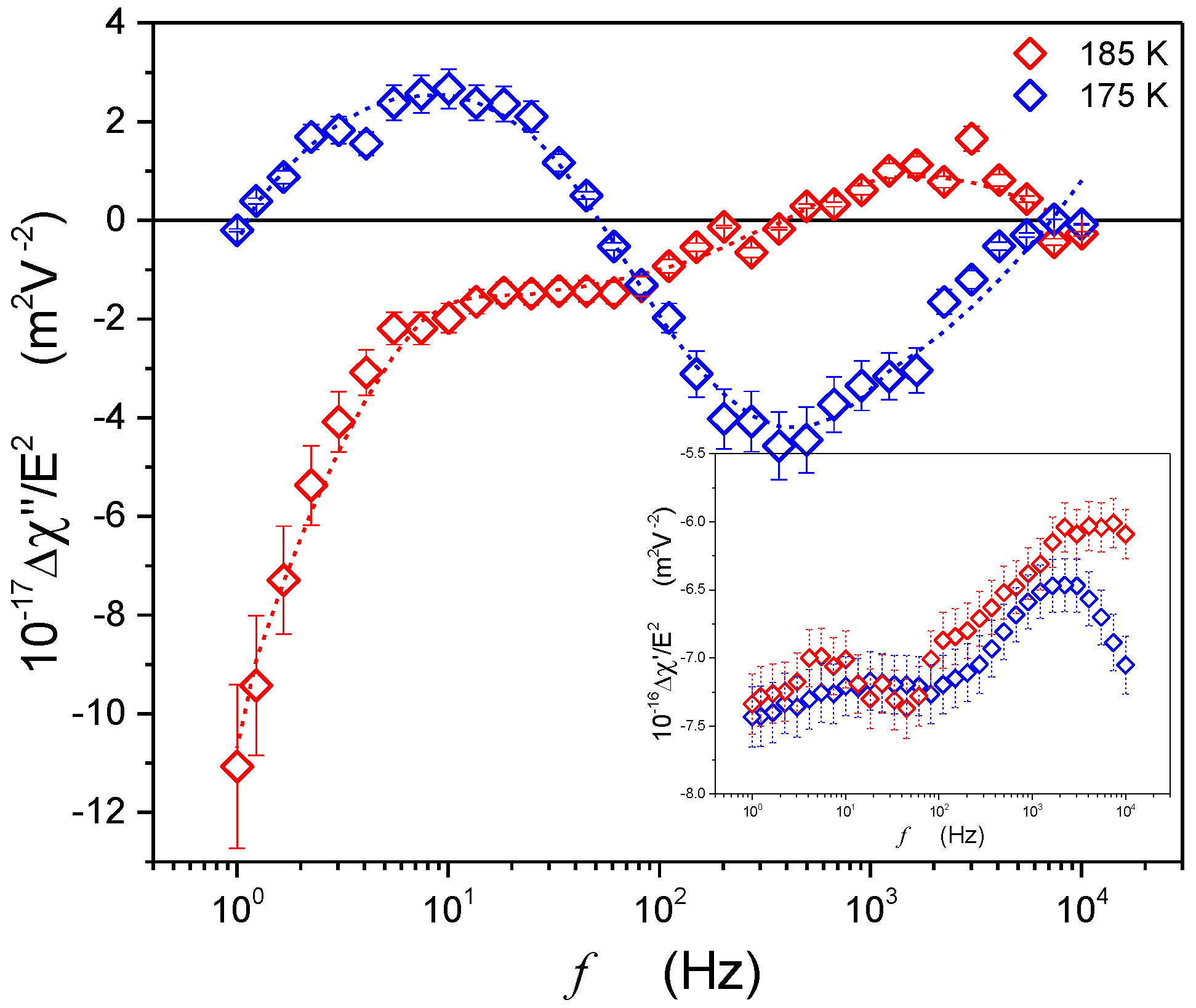
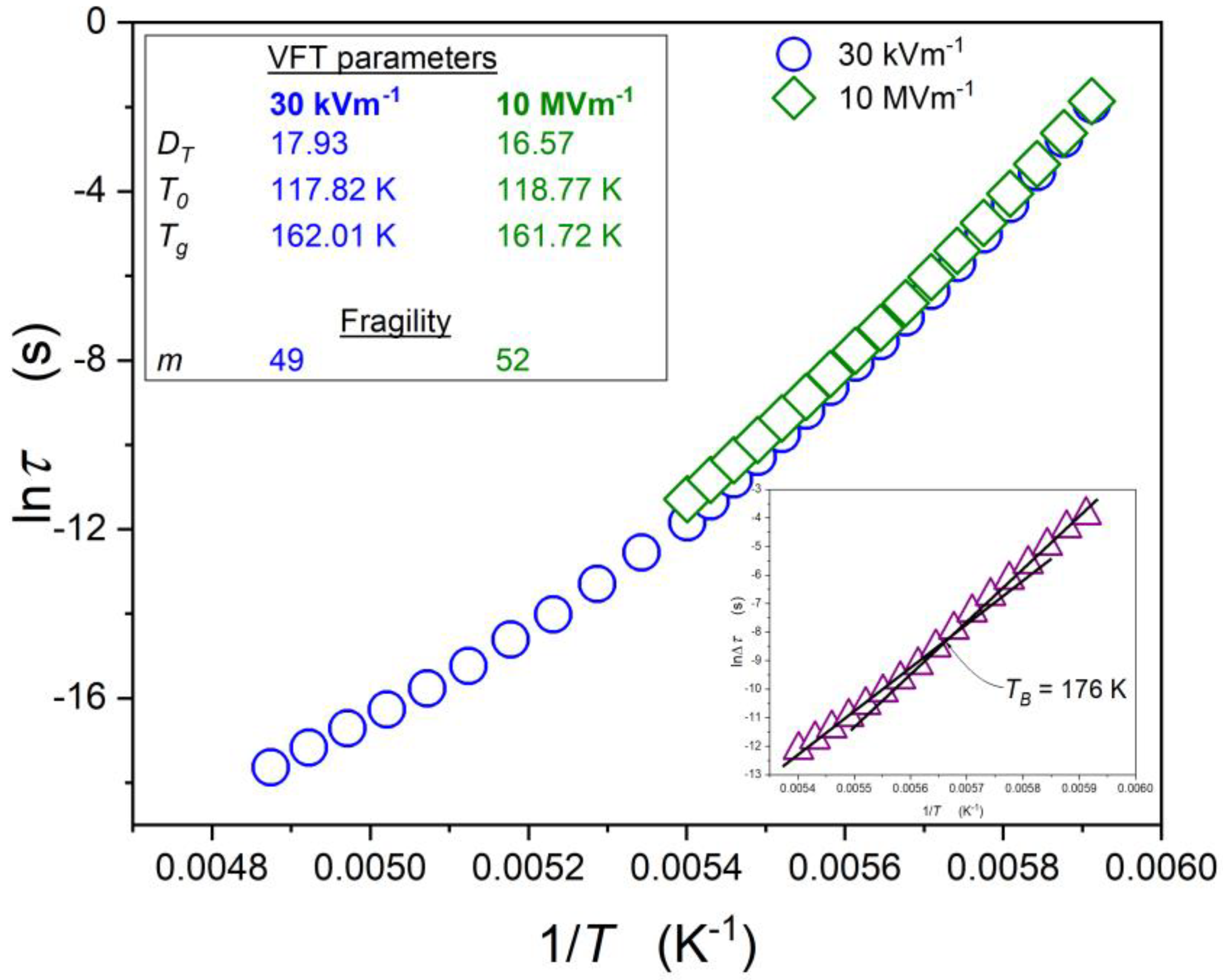
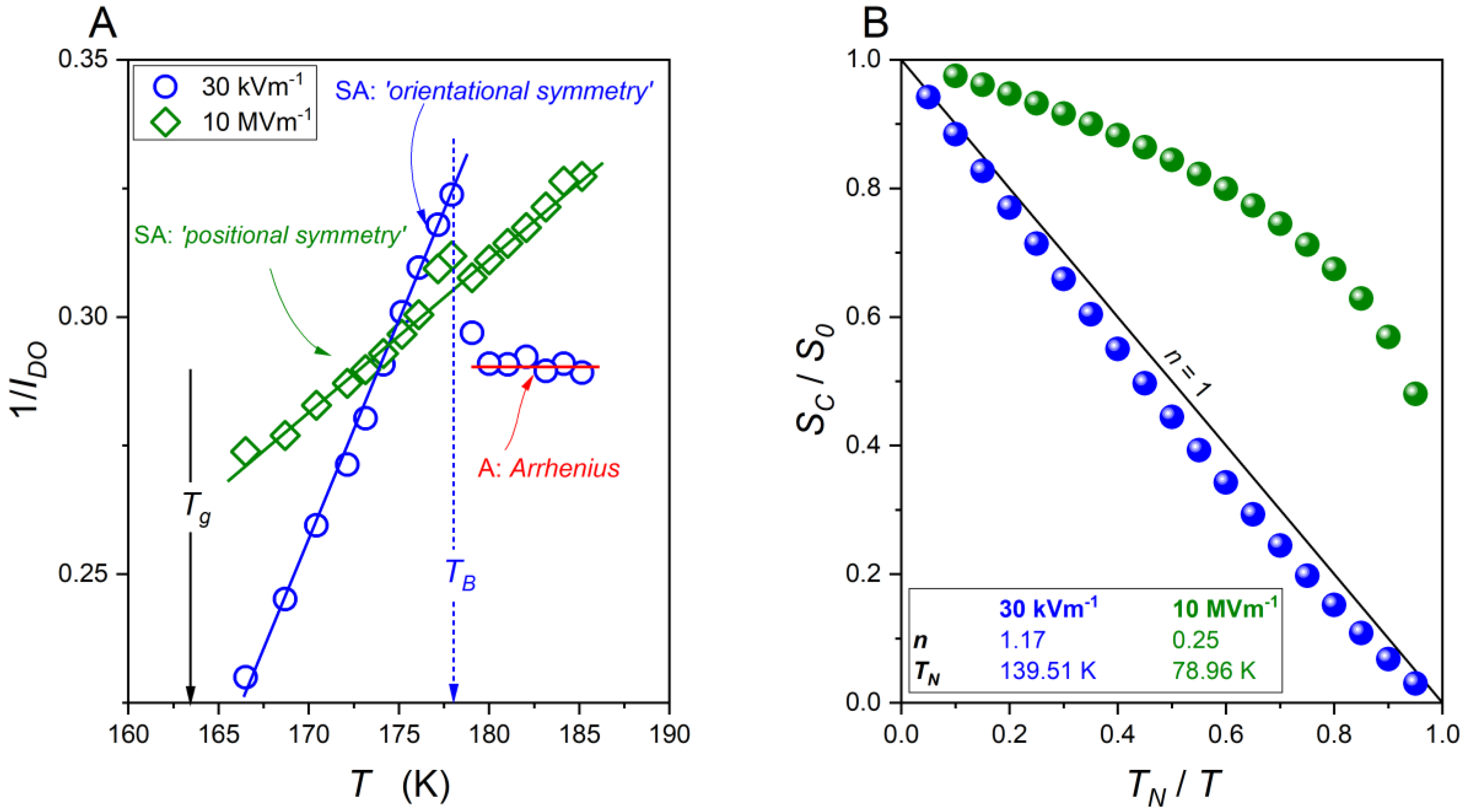
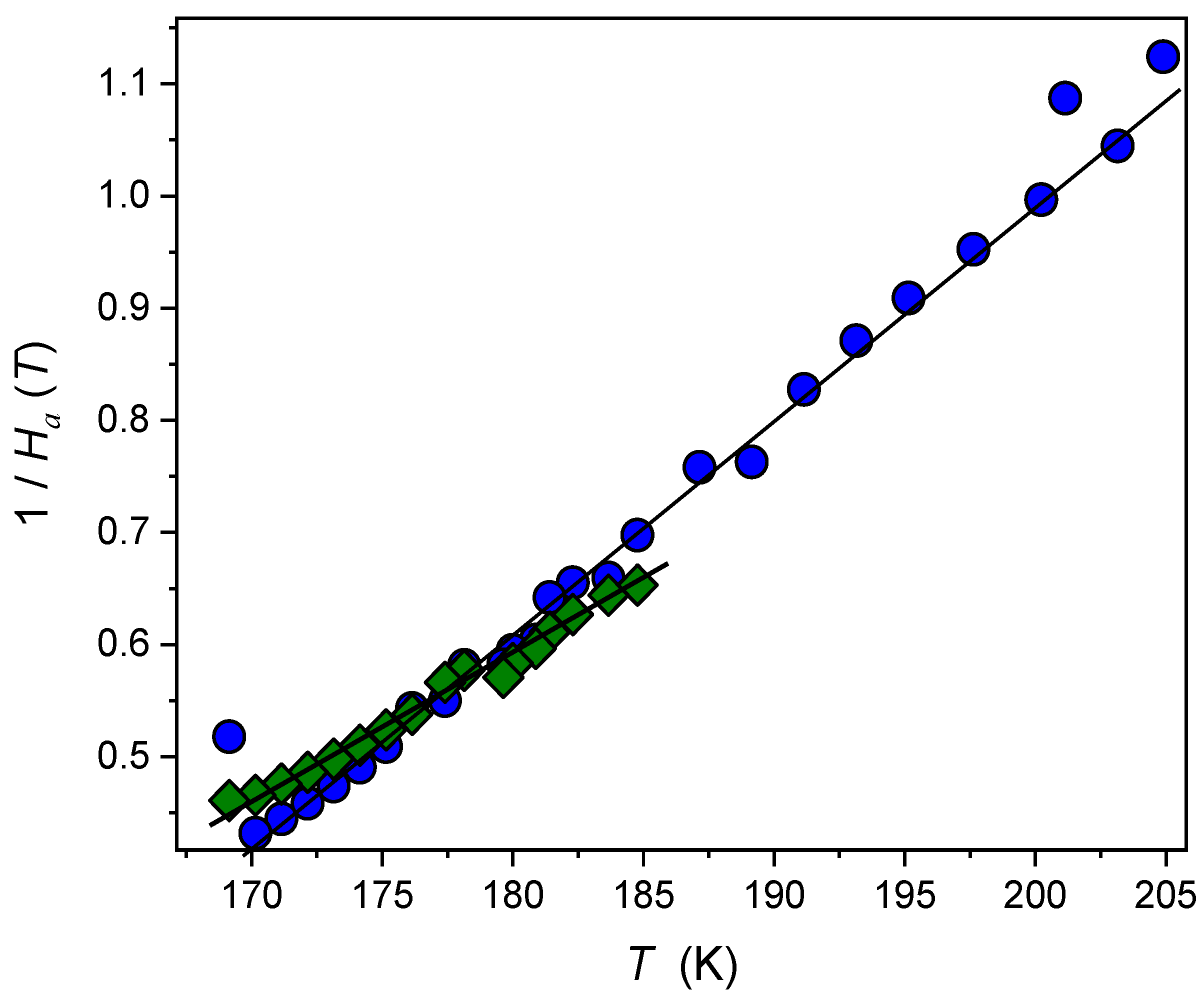
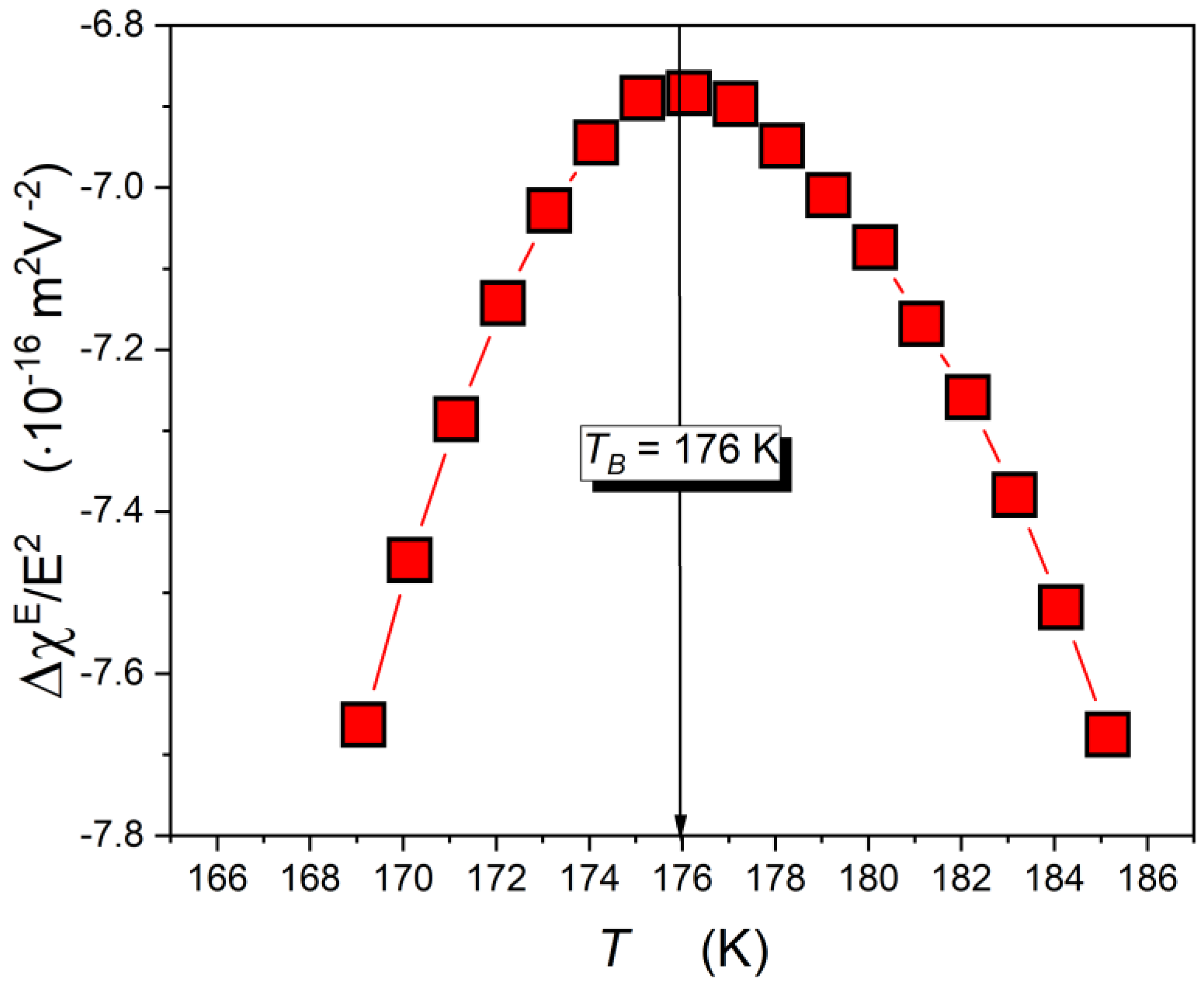
Publisher’s Note: MDPI stays neutral with regard to jurisdictional claims in published maps and institutional affiliations. |
© 2021 by the authors. Licensee MDPI, Basel, Switzerland. This article is an open access article distributed under the terms and conditions of the Creative Commons Attribution (CC BY) license (https://creativecommons.org/licenses/by/4.0/).
Share and Cite
Starzonek, S.; Drozd-Rzoska, A.; Rzoska, S.J. Long-Range Static and Dynamic Previtreous Effects in Supercooled Squalene—Impact of Strong Electric Field. Molecules 2021, 26, 5811. https://doi.org/10.3390/molecules26195811
Starzonek S, Drozd-Rzoska A, Rzoska SJ. Long-Range Static and Dynamic Previtreous Effects in Supercooled Squalene—Impact of Strong Electric Field. Molecules. 2021; 26(19):5811. https://doi.org/10.3390/molecules26195811
Chicago/Turabian StyleStarzonek, Szymon, Aleksandra Drozd-Rzoska, and Sylwester J. Rzoska. 2021. "Long-Range Static and Dynamic Previtreous Effects in Supercooled Squalene—Impact of Strong Electric Field" Molecules 26, no. 19: 5811. https://doi.org/10.3390/molecules26195811
APA StyleStarzonek, S., Drozd-Rzoska, A., & Rzoska, S. J. (2021). Long-Range Static and Dynamic Previtreous Effects in Supercooled Squalene—Impact of Strong Electric Field. Molecules, 26(19), 5811. https://doi.org/10.3390/molecules26195811







